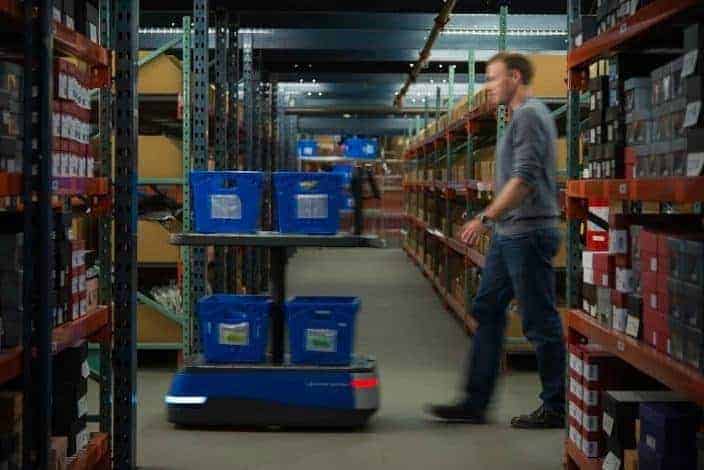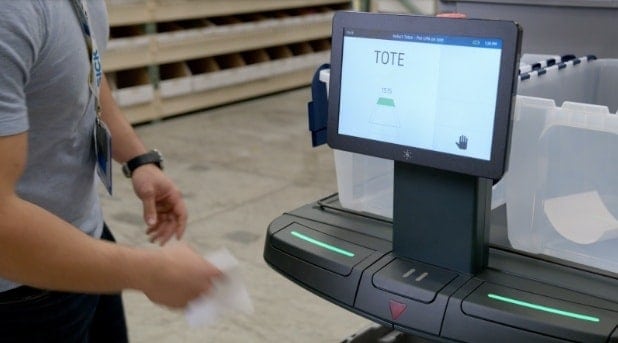Developing a picking technique that perfectly fits the needs of your warehouse can be a daunting task, especially if you’re dealing with challenges such as diverse inventory, a revolving door of pickers, a myriad of SKUs and lightning-fast picking goals. Unsurprisingly, plenty of other warehouses feel your pain, but the savviest ones have made investments for their future by incorporating automation into the picking process.
Automated warehouse picking is a collaborative effort, and it’s not just reserved for major enterprises with seemingly unlimited budgets. The best solutions can be tailor-made to add value to your existing picking processes, without the need for months of downtime or a years-long wait to achieve ROI.
Definition of automated warehouse picking
Automated warehouse picking is the implementation of robotic or semi-robotic technologies that enhance the work of human pickers. Though there is a wide range of options to choose from in the realm of automated warehouse picking, the most efficient automation tools work with your team members and can be easily integrated into existing warehouse processes quickly and seamlessly.
Automated warehouse picking can also reduce walking time and shorten picking routes, integrate with your existing WMS and support accurate picking and packing. It can be used in a broad spectrum of industries, including e-commerce, manufacturing, retail, transportation, food and beverage, medical equipment and more.
How automated warehouse picking works
As mentioned, there are all sorts of automated warehouse order picking systems on the market today, but the best kind is the one that focuses on collaboration between the picker and the robot, not the kind that aims for complete substitution.
At 6 River Systems, we developed Chuck, a mobile warehouse robot that is designed to help today’s warehouses make the most out of the labor they already have. In the past, warehouses had to rely on machines, such as conveyors, automated storage and retrieval systems and shuttles, to eliminate walking and shorten fulfillment times. However, those solutions are often bulky and less versatile compared to modern alternatives.
Because of this, we created an ultra-flexible line of collaborative robots that swiftly move across your warehouse floor, speeding up the picking rate by roughly 2-3x. Using a directed workflow approach, our collaborative robots pace your associates to help them quickly move through all the steps in the picking process, and our cloud-based software intelligently groups similar orders together to boost efficiency. Plus, Chuck works with your desired picking method, whether it’s wave, batch, zone, discrete, cluster or a combination of methods.
In short, automated warehouse picking includes the same integral steps of traditional picking methods, but without the risk of human error, slowdowns and inefficient tracking.
Benefits of automated warehouse picking
We’ve already touched on some of the benefits that come with implementing an automated warehouse picking solution, but let’s delve even deeper into how impactful the change can be for all types of warehouse operations.
- Super-fast productivity: As mentioned, mobile automated warehouse picking technologies are best known for decreasing pick times. In fact, most warehouses see their picking speeds pick up by roughly 2-3x. This is because collaborative robots are able to move across the warehouse floor faster than their human counterparts. And more importantly, they can keep going all day long, without the need for breaks or shift changes.
- Easy-to-learn: One of the best design points of Chuck is the system can be learned in a matter of minutes. This means that pickers don’t need to undergo rigorous training to begin collaborating with their high-tech counterparts.
- Safety: Robot technology meets both OSHA and ANSI standards. Relying on sensor technology, they adhere to rigorous stop accuracy and can easily navigate around humans and equipment. And because collaborative robots move on their own, they create a hands-free picking environment for operators. These benefits support a safer work environment, reducing the likelihood of on-the-job accidents and injuries for your warehouse staff.
- Flexibility: Traditional warehouse automation systems are bulky, consuming a lot of valuable warehouse space. Plus, they’re anchored in place, making it difficult to modify your warehouse layout. On the other hand, modern warehouse automation tools like collaborative robots offer a customizable approach, with flexible rental pricing to help warehouses accommodate seasonal demand.
- Rapid implementation: One of the key money-savers that go along with an automated warehouse picking investment is that the technology requires zero new infrastructure to begin working. In fact, most warehouses can start reaping the benefits of their new system within roughly 2-6 weeks.
- Scalability: In the past, accommodating peak seasonal demands with traditional approaches meant sizing an automation solution around a few months of demand. But loading your building with heavy equipment that won’t be used for most of the year isn’t the most efficient use of capital for many companies. Collaborative robots, on the other hand, can be added as needed and quickly give you incremental capacity. That means you can rent additional capacity during peak seasons or even relocate robots to other facilities should needs shift across your network of distribution and fulfillment centers.
- Adapts to your current WMS: In addition to working with your existing physical infrastructure, collaborative robots don’t require any overhauls on the IT side. In many cases, collaborative mobile robots come with software that enhances your existing WMS or WES.
- Low investment: Although your automated warehouse picking solution will very much be a prominent player in your facility, it costs less than you might think. In fact, this technology has a price tag that is one fifth that of traditional warehouse automation tools.
- Reliability: With traditional warehouse automation solutions such as conveyors, warehouse operators are putting all their eggs in one basket. They need to be able to depend on their systems to get orders fulfilled, and if a conveyor system goes down, it can bring an entire warehouse operation to a halt. But if a single collaborative mobile robot goes down, there’s no impact on throughput or operation, as other robots can simply pick up the slack.
Clearly, collaborative robots are a good fit for warehouses that want to strengthen accuracy, promote efficiency and modernize features, all without making a risky investment or making substantial changes to physical infrastructure.



